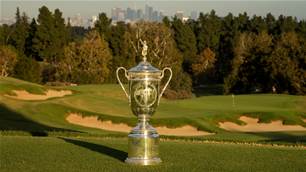Most of the focus today will be on the result of the 123rd U.S Open and Wyndham Clark’s win, and that’s as it should be.
But my thoughts for the past few days have been on Thursday of the tournament and trying to look at the game through a broader lens, particularly the way we as golfers think and talk about it.
There was much hand wringing following the first round when 37 players finished in red figures eliciting cries from several quarters that LA Country Club was ‘too easy’.
It was a sadly predictable – and narrow – reaction born out of a desire to return to the bad old days of the event when narrow fairways and choking rough were the order of the day.
That style of golf is unquestionably hard, but does that make it good?
While they’re not mutually exclusive, the terms ‘hard’ and ‘interesting’ need to live side by side when it comes to golf and not just at the U.S Open.
If scoring were the only measure of the quality of golf then perhaps the ‘too easy’ viewpoint would have some credence. But scoring is only one small part of what makes golf worth watching.
The interaction between player and course is where the good stuff is and how numbers are posted, not what those numbers are, is the determinant of entertainment.
Hard does not automatically equal good nor does it necessarily mean bad. By itself, the difficulty or otherwise of a golf hole or course is of no consequence without the far more important concept of interesting.
Low scoring golf can be fascinating to watch. Equally, and more often it has to be said, it can be boring.
"While they’re not mutually exclusive, the terms ‘hard’ and ‘interesting’ need to live side by side when it comes to golf and not just at the U.S Open." – Rod Morri.
In the same vein difficult golf is of no value unless it is also interesting. And when it is, it can be vastly more entertaining to watch than a birdie fest.
The short par-4 6th at LACC encapsulated these concepts beautifully over the past week.
As any good short two shotter does, the 6th asked one difficult and one easy question with the interest coming from the fact the player needed to decide which to answer first.
Laying up from the tee could barely have been easier for a field of this calibre but taking the easy option meant a precise second shot was required to find the green. A shot so precise, in fact, that it was not a guaranteed outcome even with a wedge in hand.
Alternatively, those players opting to go at the green from the tee brought into play some diabolical possibilities around the putting surface.
Execute the difficult shot well and an easy eagle or birdie awaited. Miss it, however, and par would be a good result.
In the third round Jon Rahm found the back bunker off the tee but so impossible was the shot directly at the flag from 75 feet he had to turn his back on the hole for his second and eventually finished 20 feet further away.
Conversely, Tommy Fleetwood’s fairway wood Sunday nestled six feet from the cup and led to an eagle that kickstarted a remarkable final round charge.
Statistically, the 6th hole was the second easiest hole for the week yet nobody could be taken seriously if they suggested it wasn’t interesting.
And that’s the most important point. Hard or easy, if the golf isn’t interesting to watch then the professional game has failed in its only reason to exist: entertainment.
Related Articles

L.A Story

Runner-up Rory rues missed putts and miscued wedge













